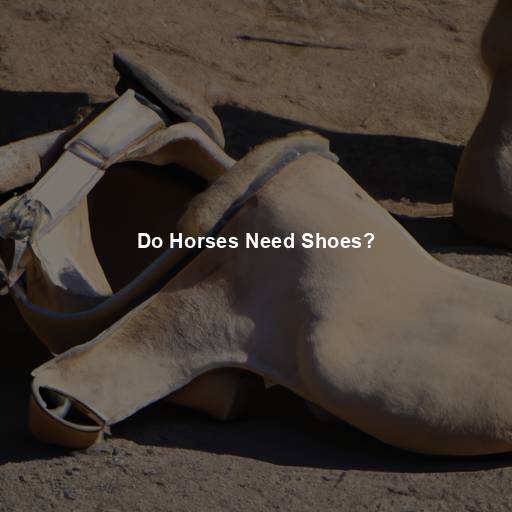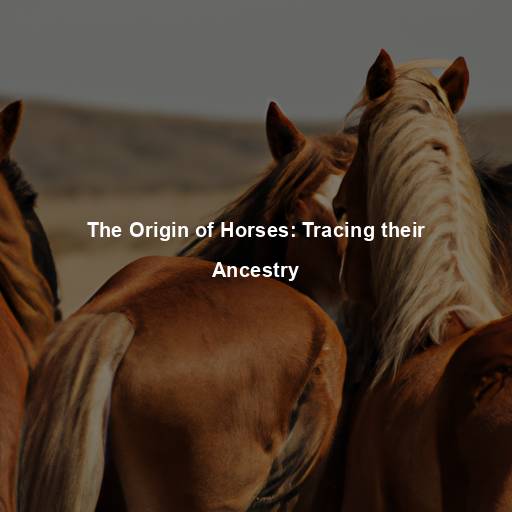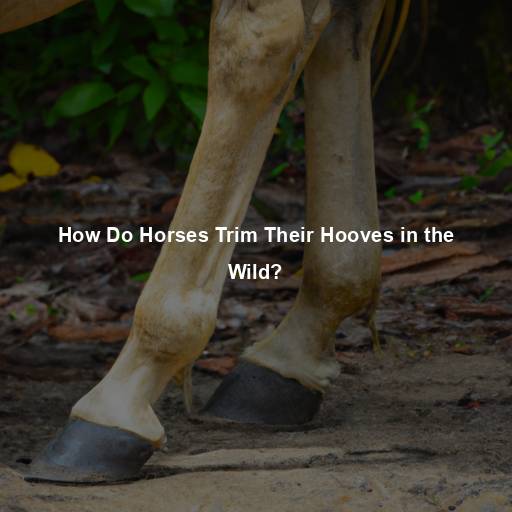Do Horses Need Shoes?
Last Updated on July 10, 2023 by Evan
Contents
- 1 The Importance of Proper Hoof Care
- 1.1 Understanding the Hoof Structure
- 1.2 Natural Hoof Function
- 1.3 The Evolution of Domestication
- 1.4 The Role of Shoes
- 1.5 When Shoes Are Necessary
- 1.6 The Importance of Regular Hoof Care
- 1.7 Working with a Farrier
- 1.8 Alternatives to Traditional Shoes
- 1.9 Potential Drawbacks
- 1.10 Alternative Approaches to Hoof Care
- 1.11 The Importance of Regular Hoof Maintenance
- 1.12 Understanding the Wild Horse Model
- 1.13 Evaluating Individual Hoof Health
- 1.14 The Role of the Farrier in Hoof Care
- 1.15 The Importance of Continual Evaluation and Adaptation
- 2 FAQs – Do Horses Need Shoes
The Importance of Proper Hoof Care
Understanding the Hoof Structure
When it comes to a horse’s physical well-being, the hoof reigns supreme as a vital and multifaceted asset. This intricate structure, consisting of the wall, sole, frog, and bars, serves as the guardian and foundation of the majestic creature. Every element intertwines in a mesmerizing dance, ensuring the horse’s soundness and resilience. Exploring the intricacies of this enigmatic hoof provides a glimpse into the captivating world of equine anatomy.
Natural Hoof Function
Out in the untamed wilderness, magnificent creatures known as horses gracefully navigate diverse landscapes, their hooves a testament to the rugged beauty of their existence. This wondrous journey across varied terrains bestows upon them a divine synchronicity, where the gentle caress of nature works its magic. As they traverse untouched vistas, their hooves experience a symphony of sensations that invigorate their very being – a dance of blood coursing through their veins, a catalyst for flourishing hoof growth, and a secret to their unwavering hoof health. It is an awe-inspiring marvel that these untamed souls, roaming freely under boundless skies, require no added protection for their precious hooves.
The Evolution of Domestication
However, with the domestication of horses and changes in their lifestyle, hoof care has become a significant consideration. Domesticated horses are often confined to stalls or pastures with limited space, and their hooves may not receive the same natural wear as their wild counterparts.
The Role of Shoes
Shoes, or horseshoes, are metal plates that are nailed or glued to a horse’s hooves. They are commonly used in equestrian activities to provide additional support, protection, and traction. Shoes can help prevent excessive wear, protect the hooves from injury, and improve a horse’s performance in specific disciplines, such as jumping or racing.
When Shoes Are Necessary
Not all horses require shoes, as their hoof health and strength can vary depending on various factors. Here are some situations where shoes may be necessary:
When it comes to horses involved in intense activities like competitive sports or intense training sessions, it’s crucial to ensure they receive proper support and protection for their hooves. In such cases, shoes can play a vital role in providing that extra layer of care. The shoes not only offer necessary support but also shield the hooves from the strains and stresses that come with rigorous activities.
When it comes to our equine friends’ delicate hooves, there can be a myriad of perplexing issues and injuries that leave them in need of some extra TLC. From troublesome cracks and weak walls to the dreaded specter of lameness, these conditions can truly throw a wrench into a horse’s stride. Luckily, there are specialized techniques and therapeutic shoes available that can burst onto the scene to promote healing and alleviate discomfort.
- Terrain and Environment: Horses that frequently traverse rough or abrasive surfaces, such as rocky trails or pavement, may need shoes to prevent excessive wear and protect their hooves from damage.
The Importance of Regular Hoof Care
When it comes to the well-being of our beloved equine companions, the importance of hoof care cannot be emphasized enough. From the perpetual debate about whether horses should wear shoes or not, one thing remains clear: keeping their hooves in top shape is paramount. By diligently scheduling regular trimmings and implementing a consistent maintenance routine, we can not only curb excessive growth but also strike the delicate balance required for optimal hoof health. Additionally, this proactive approach enables us to promptly identify and address any budding concerns, averting potential calamities that could wreak havoc on our horse’s overall soundness.
Working with a Farrier
A skilled professional known as a farrier is responsible for assessing a horse’s hooves, providing trimming services, and determining whether shoes are necessary. Farriers undergo extensive training to understand the complexities of equine hoof care and are equipped with the knowledge and skills to make informed decisions regarding shoeing.
Alternatives to Traditional Shoes
In the world of hoof care, the clanking of metal shoes has long been the norm, but for those seeking a departure from tradition, a realm of alternative options awaits. Embracing a more natural approach, horse owners are venturing into uncharted territory, exploring unconventional methods to prioritize their equine companions’ hoof health. From hoof boots that mimic the sensation of barefoot roaming to specialized barefoot trimming techniques, the realm of alternatives is vast and ripe with possibilities, promising a perplexing yet promising path for those who dare to venture beyond the realm of tradition.
Discover the enigmatic world of barefoot trimming, a captivating hoof care technique that artfully imitates the intricate patterns of wear observed in the untamed realm of wild horses. Embarking on this perplexing journey, you will be mesmerized by the arcane wisdom that guides the delicate art of trimming, harmonizing hoof growth with nature’s dance, all while shunning the conventional use of shoes. Allow yourself to be seduced by the allure of this enigmatic method, as it reveals the elusive secrets to nurturing the vitality and robustness of your equine companion’s hooves.
Introducing Hoof Boots: a revolutionary solution for our equine companions. Designed to provide unsurpassed protection and support in the face of challenging terrains and demanding activities. These remarkable boots offer a temporary shield, ensuring our beloved horses can thrive without compromising their natural hoof functionality. When not required, simply remove them, allowing our majestic friends to roam freely as nature intended.
Potential Drawbacks
When it comes to shoes, horse owners know that it’s not all sunshine and rainbows. Sure, there are some benefits to be had, but there’s a whole bag of potential drawbacks that can put a wrinkle in your horse’s stride. It’s a perplexing conundrum that demands careful consideration before strapping on those kicks. So, let’s delve into the intricacies of this equine footwear affair and shed some light on the often overlooked side of the horseshoe saga.
One of the perplexing concerns that equestrians grapple with is the potential constricting effects of horseshoes on the flexibility of their trusty steeds’ hooves. These metal contraptions, while essential for some, have been observed to restrict the natural flexion and expansion of hooves, potentially impacting blood circulation and overall hoof health. The perplexing question remains: should we continue to rely on these hoof accessories or explore alternative methods to prioritize equine well-being?
In today’s world, the relationship between hooves and shoes has sparked waves of intrigue and mystique. The notion that frequent shoeing may engender a certain dependency on these footwear marvels has captivated the minds of both equine aficionados and skeptics alike. As the hooves bear the brunt of modern living, some speculate that this constant support may hinder their inherent strength, leaving them vulnerable to natural wear and tear. The intricacies of this captivating dilemma continue to puzzle experts and evoke a sense of perplexity among those seeking to strike a harmonious balance between hoof health and the allure of fashionable footwear.
One of the lesser-known consequences of shoeing horses is the potential damage it can inflict on their hooves. The act of nailing shoes onto these sensitive structures can inadvertently weaken their overall integrity. As the process is repeated over time, the accumulation of nail holes might gradually compromise the strength of the hoof wall, raising concerns about the long-term health and soundness of the horse.
Alternative Approaches to Hoof Care
Discover the intriguing realm of holistic hoof care, where horse owners with a proclivity for the natural are invited to embark on a journey of exploration. With a plethora of alternative methods and practices waiting to be unveiled, those seeking an unconventional approach to hoof care will find themselves diving headfirst into a world of excitement and uncertainty. From traditional barefoot trimming techniques to innovative herbal therapies, the enigmatic path of holistic hoof care promises a transformative experience for both horse and owner alike. Unleash the boundless potential of your equine companion’s hooves, and embark on a quest that will leave you both mesmerized and perplexed.
Barefoot Trimming and Natural Hoof Care
Discover the revolutionary world of barefoot trimming, where hooves are expertly reshaped to mirror the rugged wear and tear experienced by untamed equine counterparts. Unleashing the power of optimal balance and unwavering function, this transformative technique nurtures the very essence of healthy hoof growth and unparalleled vitality. By embracing the natural contours of each horse’s unique hoof shape and embracing the harmonious dance of their agile movements, barefoot trimming pioneers a new path towards equine excellence and individualized care. Step into a world where tradition and innovation meld seamlessly to rewrite the hoof care playbook and embark on a journey towards unparalleled soundness and unrivaled wilderness.
In the realm of hoof care, a fascinating concept emerges that delves beyond mere trimming and shoeing. It’s called natural hoof care, and it takes a mesmerizing holistic approach to hoof health. Think of it as a symphony of nourishing diet, invigorating exercise, and a harmonious environment that collectively nurtures the well-being of those precious hooves. By encouraging regular movement on diverse terrain and facilitating ample opportunities for profound hoof stimulation and wear, this intriguing philosophy aims to unlock the full potential of equine hoof vitality.
Hoof Boots and Protective Coverings
When it comes to equine footwear, hoof boots are like fairy godmothers for horses in need of extra pampering during strenuous activities or treacherous terrain. These magical boots work their enchantment by imitating the innate functionality of hooves, ensuring both support and safeguarding. And the best part? With their effortless removal, horses can prance freely and allow their hooves to embrace their natural essence once more.
In addition to traditional hoof boots, there are various other protective coverings available, such as glue-on boots or composite shoes. These options provide alternatives to traditional metal shoes while still offering benefits like traction and protection.
The Importance of Regular Hoof Maintenance
When it comes to horses, whether they choose to rock some fancy footwear or strut barefoot, one thing remains non-negotiable – regular hoof maintenance. If you ever wondered about the secret behind their majestic gallop, here are a few crucial considerations to keep these hooves in tip-top shape.
Routine Trimming
Keeping up with regular hoof trimming is essential for maintaining the well-being of your horse. By consistently addressing hoof balance and preventing excessive growth, you can prevent any potential problems from escalating. It’s important to note that even if your horse doesn’t wear shoes, routine trimming by a knowledgeable farrier or hoof care professional is still necessary to ensure their hoof health.
Monitoring Hoof Health
Keeping a close eye on your horse’s hooves is absolutely essential to their overall well-being. By regularly checking for any signs of cracks, infections, or abnormalities, you can swiftly address any issues that might arise and provide the necessary care and treatment. Making hoof inspections a priority will not only guarantee the comfort and health of your horse but also help ward off any potential complications down the line. So, stay vigilant and be proactive in taking care of those precious hooves!
Proper Nutrition
Nutrition plays an essential role in hoof health. A balanced diet rich in essential nutrients, including biotin, zinc, and omega-3 fatty acids, can promote strong and resilient hooves. Consult with a veterinarian or equine nutritionist to ensure your horse’s diet supports optimal hoof health.
Environmental Considerations
Providing horses with access to varied terrain, including soft and hard surfaces, promotes natural hoof wear and stimulation. Regular turnout in pastures that mimic natural grazing conditions can contribute to overall hoof strength and resilience.
Collaboration with Professionals
Working closely with a knowledgeable farrier or hoof care specialist is crucial for maintaining your horse’s hoof health. They can provide guidance on appropriate shoeing or non-shoeing options based on your horse’s individual needs and activities.
Understanding the Wild Horse Model
Exploring the enigmatic world of domesticated horses requires a profound dive into the intricate realm of their hooves. Unveiling the covert secrets concealed within the natural hoof becomes paramount in comprehending the nuanced tapestry of their holistic well-being and untamed vitality. Harnessing the untapped knowledge embedded within the wild equine counterparts – masters of adaptation in diverse terrains—provides an invaluable blueprint for unlocking the enigma of equine existence. Prepare to be captivated by the enigma and profound artistry woven into the realm of these majestic creatures.
Natural Wear and Stimulation
In the vast wilderness, where horses roam freely, their journey takes them across a variety of landscapes. From lush grasslands to rugged, rocky terrains, and even the soft embrace of sandy expanses, these majestic creatures find themselves constantly on the move. This dynamic environment naturally works its magic on their hooves, as the diverse terrain stimulates blood flow, encourages healthy growth, and ensures their overall hoof well-being.
Hoof Strength and Adaptability
In the untamed realm of nature, where the wild horses roam freely, their innate survival instincts are intricately linked to the very foundations beneath them. The captivating dance of their hooves, meticulously fashioned through generations of adaptation, bears witness to their harmonious symphony with the environment. A profound testament to resilience, their hooves boast an impeccable strength manifested through a meticulously formed wall, an unwavering sole, and a tenacious frog. This extraordinary ensemble enables them to navigate treacherous terrains, absorb the jarring impact of their majestic gallop, and steadfastly sustain the noble burden of their noble frames.
Self-Maintenance and Natural Balance
Wild horses self-maintain their hooves through natural wear and movement. Their hooves naturally grow in a balanced manner, adapting to the terrain they traverse. This natural balance helps prevent imbalances or abnormalities that can lead to lameness or discomfort.
Evaluating Individual Hoof Health
When it comes to deciding if a horse requires footwear, it’s essential to carefully assess the well-being of their hooves and the overall structure of their feet. There are various critical aspects to bear in mind during this evaluation:
Hoof Conformation
Each horse has a unique hoof conformation, which can affect its ability to withstand various terrains and activities. Factors such as hoof angle, hoof shape, and the presence of any structural abnormalities should be considered when assessing the need for shoes.
Hoof Growth and Wear Patterns
Exploring the enigmatic labyrinth of a horse’s hooves holds the key to unravel the cryptic secrets of their hoof health. A meticulous study of the growth and wear patterns of these enigmatic structures grants us the ability to unearth vital insights. By diligently observing these perplexing extremities, we unveil the clandestine imbalances, elusive cracks, and intriguing abnormalities that may, at times, necessitate our intercession.
Activity Level and Terrain
When it comes to the well-being of our equine companions, one cannot overlook the pivotal role hoof health plays. The dynamic interplay between a horse’s activity level and the diverse terrain they tread upon renders hoof care a perplexing puzzle. Those elegant creatures that engage in high-octane pursuits like jumping or racing demand an extra layer of safeguarding to ward off wear and tear. Equally, horses gallivanting through treacherous landscapes, such as rugged trails strewn with rocks, may find respite in adorning their hooves with protective shoes, mitigating the ominous specter of potential harm.
The Role of the Farrier in Hoof Care
Collaboration with a skilled farrier or hoof care professional is paramount in maintaining a horse’s hoof health. The farrier’s expertise and experience ensure that the horse receives appropriate hoof care and, if necessary, proper shoeing techniques.
Regular Trimming and Maintenance
When it comes to hoof care, a farrier steps into the limelight, donning their metaphorical cape, ready to tackle the task at hand. With their expert hands and keen eye, they diligently trim and maintain the hooves, ensuring they remain in tiptop shape. Through this routine, the farrier battles excessive growth, striving for the perfect balance, while also swooping in to confront any lurking issues that may arise.
Shoeing Decisions and Techniques
When it comes to shoeing horses, the skilled farrier is like a master artist, crafting customized solutions tailored to each horse’s unique requirements. From therapeutic shoeing, targeting pesky hoof conditions, to performance shoeing, unlocking the untapped potential in various equestrian disciplines, it’s a delicate dance of expertise and intuition. The farrier’s careful evaluation and selection of techniques ensures that each horse can step confidently into a world where comfort, health, and peak performance intertwine in a beautifully orchestrated symphony of hooves.
Collaborative Approach
When it comes to taking care of your noble steed, communication is key! And we’re not just talking about horse whispering here. We’re talking about all the players involved – the owner, the farrier, and other equine professionals. They need to stay in the loop and share information about the horse’s activities, the kind of terrain they’re trotting on, and any changes in hoof health that raise a hoof-shaped eyebrow.
The Importance of Continual Evaluation and Adaptation
Hoof care should not be viewed as a static process but rather as an ongoing evaluation and adaptation to the horse’s changing needs. Regular evaluation of the horse’s hoof health, in collaboration with a farrier, allows for adjustments in trimming, shoeing, or alternative approaches as necessary.
In the world of equestrians, where the hoof reigns supreme, enthusiasts are constantly seeking ways to ensure their equine companions are in optimal shape. By embracing a holistic approach that puts the horse’s individual needs front and center, aficionados can embark on a transformative journey towards hoof health. Hand in hand with regular hoof care practices and expert advice, these horse owners will unlock the secret to unlocking the true potential of their majestic four-legged friends, leaving no stone unturned on their quest for equine perfection.
FAQs – Do Horses Need Shoes
Can horses live without shoes?
It’s a question that has left equestrians and horse enthusiasts puzzled for ages: Can horses truly live without shoes? The answer might surprise many, as it turns out that both wild horses and select domestic horses in specific environments can indeed thrive without the added protection of shoes. Nature has crafted their hooves to withstand a fair share of challenges, with continuous growth ensuring their strength and well-being. So, while the subject of equine footwear remains a source of perplexity, it’s reassuring to know that horses possess an innate adaptability to conquer the terrain.
Why do some horses wear shoes?
While it is not a necessity for all horses, there are several reasons why some horses wear shoes. One common reason is that domesticated horses often have higher activity levels and workloads than their wild counterparts. The shoes provide added protection to their hooves, especially on hard or rocky surfaces, reducing the risk of injury or excessive wear. Shoes can also help horses with specific hoof or gait issues, providing additional support and correction.
How often do horse shoes need to be replaced?
When it comes to the incredible world of horse shoe replacements, one might find themselves pondering the ever-evolving frequency of such an intriguing necessity. Ah, such a perplexing conundrum! The variables at play, my dear readers, are simply boundless – from the horse’s arduous workload to the enigmatic conditions of the terrain, and let us not forget the enigmatic nature of overall hoof health. On average, one might find that horses engaged in a moderate to heavy workload may require their trusty shoes to be replaced every 6 to 8 weeks. However, dear equestrians, it is of paramount importance to enlist the expertise of a seasoned farrier in order to embark on the noble task of hoof monitoring. These hoof heroes will skillfully unravel the mysteries of your horse’s individual needs and determine the appropriate timing for such momentous changes. Alas, their discerning eye may just be the key to early detection of any lurking issues, ensuring the prevention of discomfort or the emergence of potential hoof problems.
What happens if a horse doesn’t get its shoes replaced in time?
We all know that horses and their hooves are not to be trifled with. The importance of timely shoe replacement cannot be overemphasized. Picture this: worn-out shoes compromising the hoof’s well-being, creating a perfect storm of stress, lameness, and pain. And brace yourself for the second wave: shoes that are too small or misaligned, wreaking havoc on hoof growth and structural integrity. It’s a perplexing puzzle of equine well-being that can only be solved by regular maintenance and prompt shoe replacement. So, let’s keep those hooves happy and horses galloping with soundness intact!
Can any horse wear shoes?
Determining whether horses require shoes involves a complex jigsaw puzzle of multiple factors. While some of our equine buddies prance gracefully without shoes, others find them indispensable for their day-to-day activities. Factors like hoof quality, workload, and individual needs decipher whether shoes make a grand entrance. To untangle this perplexity, consulting a savvy farrier or veterinarian is the key, as they possess the mystical magical abilities to soundly assess a horse’s condition and provide tailored guidance on the necessity and suitability of shoes.
Do shoes cause any harm to the horse’s hooves?
When properly fitted and cared for, horseshoes should not cause harm to the horse’s hooves. In fact, shoes can provide protection and support to the hooves, preventing excessive wear and reducing the risk of injury on certain surfaces. However, poorly fitted or inadequate shoes can potentially cause problems such as sole bruising, hoof distortion, or reduced blood circulation. That is why it is crucial to have a skilled farrier who understands the horse’s conformation and hoof needs to properly fit and maintain the shoes. Regular inspections, correct shoeing techniques, and appropriate maintenance are essential to ensure the horse’s hoof health and comfort.







